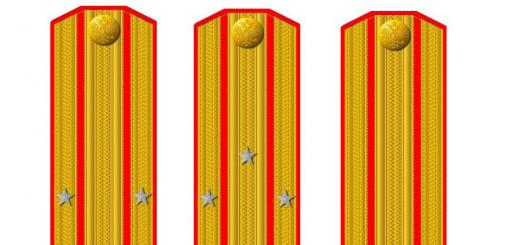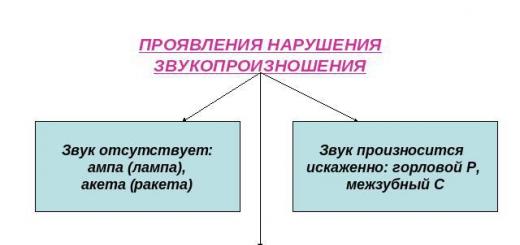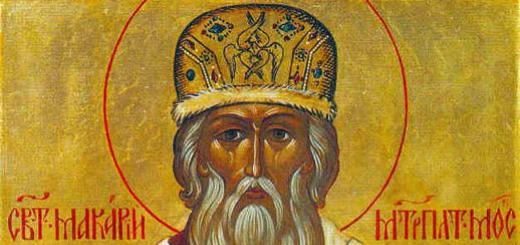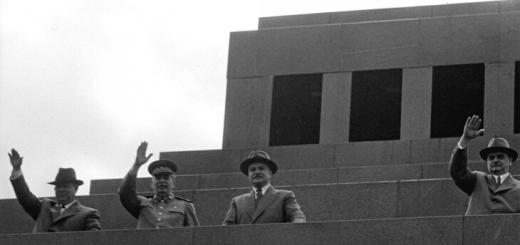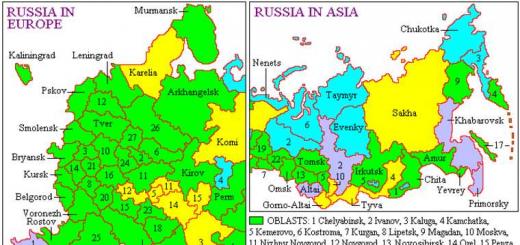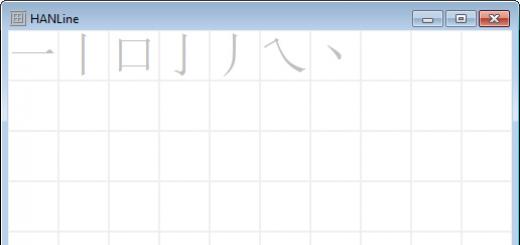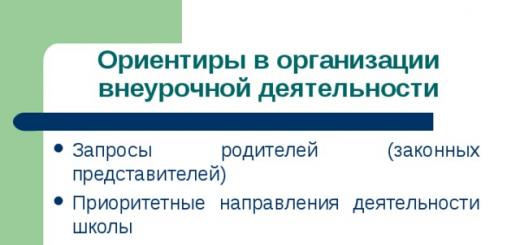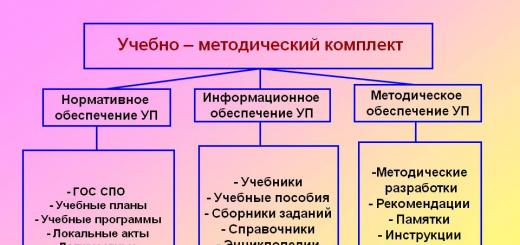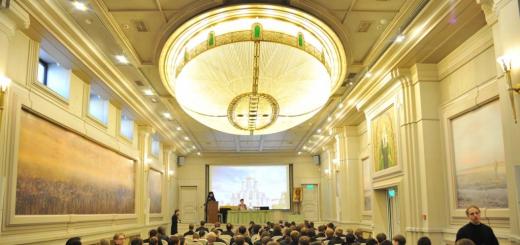There are a huge number of different methods of psychodiagnostics of human creative abilities. The most popular of them is the Torrens test.
Creativity according to Torrance (from the Latin creatio - creation) is sensitivity to tasks, deficits and gaps in knowledge, the desire to combine diverse information; creativity identifies problems associated with disharmony of elements, searches for their solutions, puts forward assumptions and hypotheses about the possibility of solutions; tests and refutes these hypotheses, modifies them, double-checks them, and finally substantiates the result.
E. Torrance developed 12 tests grouped into a verbal, visual and auditory battery. The nonverbal part of this test, known as the “Figural forms of the Torrance Test of Creative Thinking” (Figural forms), was adapted at the Research Institute of General and Educational Psychology of the Academy of Pedagogical Sciences in 1990. Another part of the test, “Complete Figures,” was adapted in 1993-1994 in the laboratory for diagnosing abilities and PVC at the Institute of Psychology of the Russian Academy of Sciences.
The E. Torrance figure test we bring to your attention is intended for adults, schoolchildren and children over 5 years old. This test consists of three tasks. Answers to all tasks are given in the form of drawings and captions.
The time for completing a task is not limited, since the creative process presupposes the free organization of the temporary component of creative activity. The artistic level of execution in the drawings is not taken into account.
Torrance creativity test, diagnostics of creative thinking:
Instructions - description for the Torrance test, stimulus material:
Subtest 1. “Draw a picture.”
Draw a picture, using a colored oval spot cut out of colored paper as the basis of the picture. The color of the oval is chosen by you. The stimulus figure has the shape and size of an ordinary chicken egg. You also need to give your drawing a title.
Subtest 2. “Completing the figure.”
Complete the ten unfinished stimulus shapes. And also come up with a name for each drawing.
Subtest 3. “Repeating lines.”
The stimulus material is 30 pairs of parallel vertical lines. Based on each pair of lines, it is necessary to create some kind of (non-repeating) pattern.

Processing the results.
Processing the results of the entire test involves assessing five indicators: “fluency”, “originality”, “elaboration”, “resistance to closure” and “abstractness of names”.
Key to the Torrance test.
"Fluency"- characterizes a person’s creative productivity. Evaluated only in subtests 2 and 3 in accordance with the following rules:
1. For assessment, it is necessary to count the total number of answers (drawings) given to the test taker.
2. When calculating the indicator, only adequate responses are taken into account.
If a drawing, due to its inadequacy, does not receive a “fluency” score, then it is excluded from all further calculations.
The following drawings are considered inadequate:
· drawings in the creation of which the proposed stimulus (an unfinished drawing or a pair of lines) was not used as an integral part of the image.
· drawings that are meaningless abstractions with meaningless names.
· Drawings that are meaningful but repeated several times are counted as one answer.
3. If two (or more) unfinished figures in subtest 2 are used to create one picture, then the number of points corresponding to the number of figures used is awarded, since this is an unusual answer.
4. If two (or more) pairs of parallel lines in subtest 3 are used to create one picture, then only one point is awarded, since one idea is expressed.
"Originality"- the most significant indicator of creativity. The degree of originality indicates the originality, uniqueness, and specificity of the creative thinking of the test taker. The “originality” indicator is calculated for all three subtests in accordance with the rules:
1. The originality score is based on the statistical rarity of the answer. Common, frequently occurring answers are scored 0 points, all others are scored 1 point.
2. The drawing is evaluated, not the title!
3. The overall score for originality is obtained by adding up the scores for all drawings.
List of answers with 0 points for “originality”:
Note: If the answer “human face” is given in the list of unoriginal answers and the corresponding figure is turned into a face, then this drawing receives 0 points, but if the same unfinished figure is turned into a mustache or lips, which then become part of the face, then the answer is scored 1 point.
· Subtest 1 - only the object that was drawn on the basis of a colored glued figure is assessed, and not the plot as a whole - a fish, a cloud, a cloud, a flower, an egg, animals (entirely, torso, muzzle), a lake, a face or a human figure.
· Subtest 2. - please note that all unfinished figures have their own numbering, from left to right and top to bottom: 1, 2, 3, ..10.
1. - number (numbers), letter (letters), glasses, human face, bird (any), apple.
2. - letter(s), tree or its parts, face or human figure, panicle, slingshot, flower, number(s).
3. - number (numbers), letter (letters), sound waves (radio waves), wheel (wheels), month (moon), human face, sailing ship, boat, fruit, berries.
4. - letter(s), waves, snake, question mark, human face or figure, bird, snail (worm, caterpillar), animal tail, elephant trunk, number(s).
5. - number (numbers), letter (letters), lips, umbrella, ship, boat, human face, ball (ball), dishes.
6. - vase, lightning, thunderstorm, step, ladder, letter(s), number(s).
7. - number (numbers), letter (letters), car, key, hammer, glasses, sickle, scoop (bucket).
8. - number(s), letter(s), girl, woman, face or human figure, dress, rocket, flower.
9. - number (numbers), letter (letters), waves, mountains, hills, lips, animal ears.
10. - number (numbers), letter (letters), fir tree, tree, twig, bird beak, fox, human face, animal muzzle.
· Subtest 3: book, notebook, household appliances, mushroom, tree, door, house, fence, pencil, box, human face or figure, window, furniture, dishes, rocket, numbers.
"Abstractness of the title"- expresses the ability to highlight the main thing, the ability to understand the essence of the problem, which is associated with the mental processes of synthesis and generalization. This indicator is calculated in subtests 1 and 2. The assessment occurs on a scale from 0 to 3.
· 0 points: Obvious names, simple titles (names) stating the class to which the drawn object belongs. These names consist of one word, for example: “Garden”, “Mountains”, “Bun”, etc.
· 1 point: Simple descriptive names that describe specific properties of drawn objects, which express only what we see in the drawing, or describe what a person, animal or object is doing in the drawing, or from which the names of the class to which the object belongs are easily deduced - “Murka” (cat), “Flying seagull”, “New Year tree”, “Sayans” (mountains), “The boy is sick”, etc.
· 2 points: Figurative descriptive names “Mysterious mermaid”, “SOS”, names describing feelings, thoughts “Let’s play”...
· 3 points: abstract, philosophical names. These names express the essence of the drawing, its deep meaning: “My echo”, “Why leave from where you will return in the evening.”
"Closing resistance"- reflects “the ability to remain open to novelty and diversity of ideas for a long time, to postpone making a final decision long enough to make a mental leap and create an original idea.” Calculated only in subtest 2. Score from 0 to 2 points.
· 0 points: the figure is closed in the fastest and easiest way: using a straight or curved line, solid shading or painting, letters and numbers also equals 0 points.
· 1 point: The solution is superior to simply closing the figure. The test taker quickly and simply closes the figure, but then completes it with details from the outside. If details are added only inside a closed figure, then the answer is 0 points.
· 2 points: the stimulus figure does not close at all, remaining an open part of the picture, or the figure closes using a complex configuration. Two points are also assigned if the stimulus figure remains an open part of a closed figure. Letters and numbers - 0 points respectively.
"Elaboration" - reflects the ability to develop invented ideas in detail. Evaluated in all three subtests. Evaluation principles:
· 1. One point is awarded for each significant detail of the drawing that complements the original stimulus figure, while details belonging to the same class are scored only once, for example, a flower has many petals - all petals are considered as one detail. For example: a flower has a core (1 point), 5 petals (+1 point), a stem (+1), two leaves (+1), petals, core and leaves are shaded (+1 point) total: 5 points for the drawing.
· 2. If the drawing contains several identical objects, then the elaboration of one of them is assessed + another point for the idea to draw other similar objects. For example: there may be several identical trees in the garden, identical clouds in the sky, etc. One additional point is given for each significant detail of flowers, trees, birds and one point for the idea to draw the same birds, clouds, etc.
· 3. If items are repeated, but each of them has a distinctive detail, then you must give one point for each distinctive detail. For example: there are many colors, but each has its own color - one new point for each color.
· 4. Very primitive images with minimal “elaboration” are scored 0 points.
Interpretation of test results Torrance .
Add up the scores for all five factors (fluency, originality, abstractness of title, resistance to closure, and elaboration) and divide the sum by five.
The result obtained means the next level of creativity according to Torrance.
Many people want to find out how creative and intellectually developed they are in relation to the people around them. This can be done using various tests, one of which is the Torrance test for creative thinking.
This test is very simple. It consists of three stages, adapted for people of any age, starting from 5 years. Naturally, if you want to know your relative result, you need to test several people your age. Previously, we told you about other tests that can also tell you the level of your creativity.
Torrens test
Stage one: draw a picture. In this case, you will need an oval similar in size to a chicken egg. Its color can only be determined by you, but it is better that it be the same for all subjects. In this regard, the easiest way would be to take white color by making an oval from plain paper.
The subject must draw something in the oval so that the oval turns into something concrete thanks to your addition. You definitely need to give this drawing a title. You can draw whatever comes to your mind. Test time is 1 minute.
Stage two: associative thinking. Based on the table below, you need to do the following. Complete each picture as you see it and give it a title. Test time - 3 minutes.
Stage three: regular thinking. Print the picture below again. For each identical element (in this case, a pair of horizontal circles), it is necessary to add something unique to make something original, meaningful and understandable. Roughly speaking, drawings and their interpretations should not be repeated. There can be 30 drawings in total. Test time - 5 minutes.

Scoring
Creativity is assessed in 5 stages: productivity, originality, thoughtfulness, openness, logic.
Productivity. Evaluated in stages 2 and 3. Count the total number of the subject's answers - how many pictures he completed, the number of points he will receive. The point is not counted if:
- the original part of the drawing was not used;
- if there is no meaning in the picture or its title;
- repetitions.
Originality. Evaluated on all three test items. The most important thing here is that any of your drawings are not repeated. If there are statistical data, there are a lot of varieties of the test, so offer it to many people so that you have something to compare with. That is why first try to give this test to at least 40-50 people, so that you can then see your results. Based on all tests, the same drawings are selected. This is not difficult to do if you conduct the test in a classroom where all subjects are sitting together and are in equal conditions.
Each original answer is worth one point. Originality is determined as follows: if at least 50% of the subjects have a drawing from any task, then it is no longer original. All other options are considered original and give you 1 point. If no one else has a picture and name like yours, then this gives you 5 points right away. If there are more than 100 subjects, then you will receive 10 points for an original answer.
Thoughtfulness. For each thoughtful drawing in any of the last two tests, 1 point is given. The thoughtfulness lies in the presence of not only contour drawings, but also small details inside each drawing. In the first drawing, each additional point is awarded for a detail of the drawing that does not change the meaning, but complements it and makes the drawing more understandable, accurate and legible. I would like to note that in the case of test children, the drawings from the first task can also tell a lot about their inner world - another one will help you with this.
Openness. The assessment is carried out only on the second test. If the figure does not turn into a closed pattern, then you get 0 points. If, for example, the nose turned into part of the head, then you will receive 2 points for each such drawing. If you drew a mustache without a face, it’s 0, but if this mustache is part of a full face, then it’s 2 points.
Logics. It is calculated in tests No. 1 and No. 2. Here it is important to grasp the essence of the name - how well it corresponds to the picture.
- If the title is illogical or consists of one word that clearly describes the picture, then you get 0 points.
- A name with properties, for example: a hot bun or a beautiful mustache, is worth 1 point.
- Any abstract names that reflect some meaning are worth 3 points. Examples: The futility of existence, the sad, merry fellow, and so on.

Bottom line
Calculate the number of points. If you believe the statistics and take the average scores for similar tests, then you should get 40-50 points. This is the norm. Anything more is good, because it speaks of your non-standard thinking.
Any such tests are relative. They are not completely objective, so they require a huge amount of testing and analysis. To find out a more accurate result, conduct the test on 100 people, and only then carry out the analysis, since otherwise you will have to check the results for originality after each new subject and recalculate the scores.
We wish you good luck in testing. The point is to make quick decisions - everything needs to be done as quickly and thoughtfully as possible. To improve your skills in effectively making important and correct decisions, seek help from our other article. Be happy, successful and don't forget to press the buttons and
The first creativity tests were created by J. Guilford and his associates at California State University in the 50s. XX century These techniques, known as the Southern California Divergent Productivity Tests, measured characteristics of a type of thinking that J. Guilford called divergent thinking. 14 tests were developed. In the first ten, the subject was required to give a verbal answer, and in the last four, he was required to compose an answer based on pictorial content. Examples of verbal tasks:
Ease of use of words. Write words containing the indicated letter (“O”: burden, pot, again...).
Ease of use of associations. Write words similar in meaning to this word. (“Heavy”: difficult, weighty, severe...)
Example of a visual task:
Decor. The contours of well-known objects must be filled with as many details of these objects as possible.
J. Guilford's tests are aimed at adults and high school students. Their standardization was carried out on small samples, and data on reliability and validity vary markedly from test to test and are not satisfactory. According to psychologists, the reasons for the low effectiveness of J. Guilford's tests in assessing creative abilities are the focus on the speed of completing tasks and the failure to take into account personal characteristics.
In addition, the tasks in them do not require a certain number of answers, which prevents the objective calculation of their indicators. For this reason, according to some psychodiagnosticians, for creativity tests it is necessary to establish the reliability of the specialists assessing their performance.
Currently, the most famous and widely used to measure creativity are E. Torrance's Tests of Creative Thiming (TTCT). Despite his declared goal of constructing test tasks as a model of the creative process and reflecting in them not the result, but the process of creativity, in reality, the Torrance tests (especially verbal) are essentially similar to the Southern California tests of J. Guilford, and sometimes are their adaptation [10, t 2]. In addition, the test indicators were borrowed by E. Torrance from J. Guilford. However, E. Torrance did not try to create factorially pure (that is, reflecting one factor) tests, but sought to reflect in them the complexity of creative processes. Their formal characteristics (reliability, validity) are slightly better than those of J. Guilford, but still insufficient.
E. Torrance developed 12 tests grouped into a verbal, visual and sound battery. He preferred not to use the term “creativity” in the names of his methods, designating them as batteries for verbal, visual and verbal-sound creative thinking. To relieve anxiety and create a favorable creative atmosphere, E. Torrence called his methods not tests, but classes.
The verbal test, developed in 1966, is intended for children aged 5 years and older and adults. It consists of 7 subtests. The first three are questions related to one picture: the subject is asked to ask as many questions as possible about the picture, guess as many
but more than the causes and consequences of what is depicted on it. In subtest 4, you should come up with as many interesting and unusual ways as possible to change the toy shown in the picture. Subtest 5 requires you to come up with as many interesting and unusual uses as possible for an object known in everyday life (for example, an empty box). In task 6, you should come up with as many unusual questions as possible about the same subject. Subtest 7 requires you to imagine an unusual situation and make as many guesses as possible about its possible consequences. The time to complete each subtest is limited. The test is group and has two parallel forms A and B. The main indicators for the test are fluency, flexibility, originality and thoroughness of development.
This test has been translated into Russian, but there is no data on its testing for reliability and validity, as well as on standardization on a domestic sample. Therefore, the E. Torrance verbal test in our country can be used only for research purposes.
The E. Torrance figure test also appeared in 1966. Its translation, adaptation and restandardization for domestic subjects were carried out by E. I. Shcheblanova, N. P. Shcherbo and N. B. Shumakova. It is intended for subjects from 5 to 18 years of age. This test consists of three subtests. Answers to all tasks are given in the form of drawings and captions.
Subtest 1 “Draw a picture” requires subjects to stick an irregularly shaped figure cut out of colored paper onto a sheet of paper and draw any original picture based on it. In subtest 2 “Finish the drawing”, you should draw unusual pictures or objects based on the unfinished figures depicted in the test notebook. In subtest 3 you need to draw as many objects as possible based on parallel lines or circles. The time for completing each subtest is limited to 10 minutes. (analysis of answers is carried out according to the criteria of fluency, flexibility, originality and thoroughness of development).
The Verbal-Auditory Creative Thinking Battery consists of two tests administered using a tape recording. The first test, “Sounds and Images,” uses sounds as an object for recognition, the second, “Onomatopoeia and Images,” uses onomatopoeic words, that is, words that imitate natural sounds (for example, reminiscent of creaking or crackling). The first test consists of four sound sequences presented three times, the second test consists of nine words presented four times. In both tests, after listening to a sound recording, the test taker must write down what he thinks each sound sounds like. Answers are judged only on originality. This battery was not used in our country.
Another, most recent test of creativity (for preschoolers), manifested in action and movement, was developed by E. Torrance in 1980. The tasks of this test are designed in such a way as to give the child the opportunity to demonstrate his creative abilities in the process of free movement in any room. The same 4 indicators of creativity are recorded as in other E. Torrance tests.
Despite the desire of psychologists to contrast creative thinking with reproductive thinking, in practice, creativity tests were built on the same principles as intelligence tests, that is, they were high-speed methods with strictly defined content. Researchers believe that their main drawback is the failure to take into account the motivation and other personal characteristics of individuals, which are essential aspects of creative abilities.
There is insufficient data on the connection between E. Torrance's tests and criteria for creative achievements. Some point to their low predictive power. Thus, a study by D. Kogan and A. Pankov, which compared the results of measuring the creativity of students in grades V and X with creative achievements at the end of school (after 7 years and 2 years, respectively), showed that the correlation coefficients for fifth graders are equal to 0, and for class X - very small and insignificant.
Apparently, it is impossible to predict creative achievements using creativity tests in science, technology, art and other areas of human activity, since these achievements require a complex combination of abilities (including intellectual and special ones) and personality traits. Currently available creativity tests focus on individual elements of creative ability, but this is not sufficient to predict creative achievement. Thus, flexibility and originality of thinking, greater divergent productivity are important for creative achievements, but critical assessment of emerging ideas is no less important. In a truly creative act, a phase of uninhibited divergent productivity is followed by a phase of critical evaluation. For example, during brainstorming, the productive and evaluative phases are separated in time; critical evaluation of ideas can only be hindered in the early stages of creative activity, but critical evaluation can be eliminated only for a time, and not abolished forever. Some psychologists believe that creativity can only be measured by analyzing individual acts of creativity.
In Russian psychology, much attention is paid to revealing the essence of creativity, clarifying the mechanisms of creative activity and the nature of creative abilities. As for diagnosing creativity, it should be noted that there is almost no work in this direction. We will only note the research conducted by D. B. Bogoyavlenskaya.
She singled out a unit for measuring creative abilities, called “intellectual initiative.” She views it as a synthesis of mental abilities and the motivational structure of the individual, manifested in “the continuation of mental activity beyond the limits of what is required, beyond the solution of the problem that is set before the person.” To identify intellectual initiative, D. B. Bogoyavlenskaya abandoned the traditional test model for measuring creativity, suggesting that the organization of specific, voluminous, two-layer activity is necessary. For this purpose, a system of similar tasks containing a number of general laws is suitable. Such a system of tasks ensures the identification of the first (superficial) layer, which consists in the activity specified by the instructions for solving them, and also creates conditions for the second, deep layer, which is not obvious to the subject, consisting in the activity of identifying hidden patterns that the entire system of tasks contains, but the discovery which are not required to solve them. Intellectual initiative is manifested in the independent formulation of a research problem, not stimulated by the utilitarian need to fulfill the task of the methodology. Going beyond the given limits, the ability to continue cognition beyond the requirements of the situation is a personality trait that reflects the interaction of cognitive and motivational factors. In accordance with the hypothesis, D. B. Bogoyavlenskaya proposed the “creative field method”, which allows the subject, without the influence of an external stimulus, to move from carrying out a given activity to a theoretical generalization and analysis of a given situation. Principles of the “creative field”:
- 1) refusal of an external stimulus and prevention of evaluative stimulation;
- 2) the absence of a “ceiling” in the study of an object - an unlimited field of activity;
- 3) duration of the experiment.
Within the framework of this method, several techniques were constructed and tested for validity. The author experienced significant difficulties in finding an external criterion. Creative success was determined by the method of expert assessments, which has a number of disadvantages. The obtained correlations of experimental assessments of intellectual initiative with an external criterion are very high, but the subjectivity of the selected criterion does not allow conclusions about the validity of the developed methods to be considered final. Work in this direction continues.
Questions and tasks
- 1. How did the problem of research and diagnosis of creativity arise?
- 2. Name the main directions of creativity research in foreign psychology.
- 3. How do creativity and intelligence test scores compare?
- 4. Describe the creativity tests of J. Guilford and E. Torrance, note their advantages and disadvantages.
- 5. How do D. B. Bogoyavlenskaya’s interpretation of the phenomenon of creativity and its diagnosis differ from the approaches of J. Guilford and E. Torrance?
- 6. How accurate and practically justified is the forecast of creative achievements based on the results of creativity tests?
- 1. Anastasi A. Psychological testing. T. 2.-- M., 1982.
- 2. Bogoyavlenskaya D. B. Intellectual activity as a problem of creativity. -- Rostov n/d., 1983.
- 3. Bogoyavlenskaya D. B. Psychology of creative abilities - M 2002.
- 4. Matyushkin A. M. Mysteries of giftedness. -- M., 1993.
- 5. Gifted children / Ed. G. V. Burmenskaya and V. M. Slutsky - M., 1991.
- 6. Psychology of giftedness in children and adolescents / Ed. N. S. Leytes. - M., 1996.
- 7. Shcheblanova E. I., Shcherbo N. P., Shumakova N. B. Figured form of the P. Torrens test of creative thinking. Methodological recommendations for working with the test. -- M., 1993.
Creative problem solving [How to develop creative thinking] Lemberg Boris
Creativity test
Creativity test
The “Creativity” test, developed by psychology professor N.F. Vishnyakova, allows you to identify the level of a person’s creative inclinations and build a psychological creative profile. To do this, the test comprehends the creative component of the real image (“I-real”) and the representation of the ideal image of oneself (“I-ideal”). Comparing two images of creativity – “Real Me” and “Ideal Me” – allows us to determine the creative reserve and creative potential of an individual.
With this test you can independently assess your personal qualities. Read the instructions carefully.
If the answer to the question is positive, put a “+” sign, if negative, put a “-” sign in the column “Real Me” and “Ideal Me.” Don’t think about your answer for a long time, answer according to your first impulse, in accordance with your first impression.





Processing the results
The number of points for each creativity index is determined by the test key by summing up the points received. If your answer to a question matches the test key, you receive one point for this index indicator: “Real Self” and “Ideal Self.” For example, if you answered the first question in the affirmative (“+”) in the column “I-real” and “I-ideal”, and the answer key is “+”, then for the first index M (creative thinking) you get one point each, If the answer is negative (“-”), then you do not receive anything. Also remember that the key to the test applies for each quality not only to the “Real Self”, but also to the “Ideal Self”.
Table of results in points

Key to the test




Psychological profile
To construct a psychological profile of creativity, draw two circles. The first circle is “I-real”, the second circle is “I-ideal”. Divide each circle into eight parts. Mark the resulting axis segments from the middle into ten equal parts. Points are deposited on them, which are marked with dots on the axis of each creative indicator. They demonstrate the level of eight identified creative tendencies that, when the dots are connected, form a psychological profile of creativity.
The indicators in the upper part of the circle (1, 2, 8) correspond to the conscious processes of a creative personality.
The indicators of the lower part (4, 5, 6) correspond to the subconscious processes of a creative personality.
Indicators 3 and 7 refer to borderline conscious-subconscious mental processes.
To determine the reserve and creativity of your personality, combine these circles, marking the contours of the “Ideal Self” profile with a red line and the “Real Self” profile with a blue line.
From the book Business Psychology author Morozov Alexander VladimirovichTest No. 9 SPIELBERGER-KHANIN test. ASSESSMENT OF EMOTIONAL STATE (LEVEL OF REACTIVE AND PERSONAL ANXIETY) Using this test, the level of anxiety at the time of its completion (RT) is determined, reflecting the reaction to a short-term situation and the level
From the book I'm Right - You're Wrong by Bono Edward deCreativity In the history of our culture, we have done surprisingly little on the issue of creativity, while recognizing that progress largely relies on it. There are a number of reasons why we have achieved so little. Deep faith in desktop logic, science in general
From the book Motivation and Personality author Maslow Abraham HaroldCreativity of self-actualization As a consequence, I found it necessary to distinguish between “creativity of talent” and “creativity of self-actualization,” the latter being much more widespread and having a closer connection with the individual, not manifesting itself in everyday life.
From the book Greek Goddesses. Archetypes of femininity author Bednenko Galina Borisovna From the book Anatomy of Stupidity author Lindholm MarinaCreativity I constantly talk about creativity, about the ability to create something new, about creativity. Let's look at this, because the topic is very interesting. I am very touched by women's magazines on needlework, where the tabs with patterns include not only patterns for blouses and
From the book Psychology of Creativity, Creativity, Giftedness author Ilyin Evgeniy PavlovichTest “Freedom of Associations” (imaginative creativity) As shown by Z. Siewert (Personality Testing, M., 1997), this test has broad information content and allows you to determine the level of development of the ability to associate, visual creativity, the ability to
From the book Development Training with Teenagers: Creativity, Communication, Self-Knowledge author Gretsov Andrey GennadievichTest of remote associations by S. Mednik (verbal creativity) The test is adapted by T. V. Galkina, L. G. Alekseeva, L. G. Khusnutdinova. Forty verbal triads are used as stimulus material in the test. The elements of each triad belong to mutually distant
From the book Psychology of General Abilities author Druzhinin Vladimir Nikolaevich (Doctor of Psychology)Creativity and its development The first stage of all creativity is self-forgetfulness. M. Prishvin The essence of creativity Understanding the essence of creativity and the abilities that underlie it is a question on which there are many contradictory psychological,
From the book Communication Training in 14 Days author Rubshtein Nina ValentinovnaCreativity and its diagnosis The concept of “creativity” in the context of psychological knowledge acquired significance only in the early 50s. In 1950, a pioneer in the field of creativity, J. Guilford, delivered his inaugural address as president of the American Psychological Society.
From the book Serious Conversation about Responsibility [What to do with disappointed expectations, broken promises and inappropriate behavior] author Patterson KerryCreative behavior The main enemy of stable relationships is the same type of behavior. A person who always behaves the same way is unbearably boring and inadequate to what is happening, since the world changes daily. And even every minute. Stay fresh in
From the book How to Speak Correctly and Without Embarrassment author Polito ReynaldoWhat is creativity? During a performance review, Barb discusses his performance with her subordinate Johnson and advises him to be more creative. She says, “Next quarter, I want you to be more creative. Suggest your own ideas." Trying
From the book Game [How it affects our imagination, brain and health] by Brown Stewart5. Creativity You ask people to give you some attention, and... nothing happens. Then you ask again: “Please give me a moment of attention.” In response, you will see several raised eyebrows and glances from the listeners, very reminiscent of dead fish, turned to
From the book Psychology of Motivation [How deep attitudes influence our desires and actions] author Halvorson Heidi GrantCreativity and Innovation The biggest reason why companies invite me to talk about gaming is its role in creativity and innovation. They want to talk about the game because they rightly view it as their most precious resource.
From the book Creative Confidence. How to release and realize your creative powers by Kelly TomCreativity and Innovation Our colleague Ray, who always strives to succeed, is hard to beat when it comes to creativity. Most researchers move forward methodically, in logical steps, building on what is known and adding new data.
From the book Bad Habits of Good Children author Barkan Alla IsaakovnaCreativity now “Creativity” is a much broader and multifaceted concept than “artistry”. We believe that creativity is the activity of using imagination to create something new in the world. She comes into play every time
From the author's bookVM test (indicative test of school maturity - verbal thinking) I. Irazek Which animal is larger - a horse or a dog? Horse = 0, incorrect answer = -5. In the morning we have breakfast, and at noon...? We have lunch. We eat soup, pasta and meat = 0. We have afternoon, dinner, sleep, etc. incorrect
Creativity is highly valued in the modern world - the demand for people in creative professions is growing in the labor market. The ability to solve any situation in an original way can be useful not only at work, but also in everyday life. It is no coincidence that both parents and educators ask the question of whether a child has creative abilities. The existing potential should begin to be developed as early as possible. You can find out how creative a child is using the E.P. test. Torrens.
Characteristics of the creativity test by E.P. Torrance
The author of the technique is Alice Paul Torrance, a famous American psychologist who devoted his life to the study of creative thinking and made a great contribution to the theoretical and practical study of mental processes. As a teacher, he worked with gifted children for many years. The tests were compiled to identify hidden creative abilities, as well as to develop corrective training programs, the emphasis of which was on an individual approach to each student. Fully aware of the complexity of assessing creative potential, which cannot be measured in quantitative terms (unlike intelligence level), Torrance nevertheless sought to create a reliable methodology for studying it. The diagnostic results have a high degree of reliability, since the technique was developed based on the results of long-term studies conducted on a large number of subjects.
The Torrance Creative Thinking Test is intended for children of senior preschool (5–6 years old) and school age (from 7 to 18 years old). It consists of 3 parts:
The procedure for diagnosing creative thinking
It is recommended to conduct the test in small groups - from 5 to 10 people. Moreover, the younger the participants, the fewer of them there should be in the association. The subject is supposed to sit at the table alone or with an assistant experimenter, who will explain the task or sign the drawing if the child does not do it well and quickly enough on his own. For preschool children, it is better to organize the test individually.
To obtain objective results, testing should not include an element of competition or imply that there are “correct” answers. On the contrary, the study should take place in a relaxed and calm environment in which children can reach their potential without fear of receiving a bad grade. It is best if the experimenter presents the tasks in a playful way. This will not be so difficult to do, since the tests were originally intended for children of senior preschool and school age, so the author tried to make them non-trivial in order to interest the test takers. Recommendations for preparing children for upcoming work include phrases like: “Guys! I'm sure you'll enjoy the upcoming game. This will help us understand how you can come up with new things and solve different problems. You will need to use all your imagination and ability to think.”
To complete the tasks, test participants need paper, pencils and pens. It is better to remove from the table all unnecessary objects that may distract children. Subjects are also provided with sheets of stimulus material. To avoid confusion, children should be reminded that forms must be signed. It is recommended to preface the test with an introduction like this: “You have unfinished figures in front of you. If you add something to them, you will get interesting pictures and stories. You need to do this in 10 minutes. Try to invent an object or plot that no one else will draw. Come up with an unusual name for each image.”
Some sources say that children should not be limited in time, as this may interfere with the harmonious flow of the creative process. The original test description states that 10 minutes are allotted for each subtest, so the experimenter will need a stopwatch. If participants are concerned about this, they should be warned not to worry and to work at their own pace: “You work at different speeds. Some people manage to do everything very quickly, and then return to the tasks and finish them. Others draw little by little, but make complex and interesting stories out of each picture. Do what is most convenient for you."
The experimenter should definitely ask if there are any questions. In case of confusion, you will need to repeat the instructions in simple and accessible language, taking into account the age of the subjects. But in no case should you provide examples of test execution, as this may lead to a decrease in the originality of the work.
At the end of testing, the organizer needs to make sure that an appropriate comment is given for each drawing. If a child forgets to label any image, the experimenter or his assistants should immediately find out the answers and label the stimuli themselves. Otherwise, it may be difficult to interpret the results. That is why there should be enough assistants to cover the entire group of subjects.
The Torrance Creativity Test can be repeated to assess the development of creative abilities. It is recommended to use the following explanations: “We want to understand how your ability to come up with new things and solve problems has changed. People measure their height and weight regularly to see how much they have grown and gained. We do almost the same thing, but only for the purpose of exploring your abilities. Try to be the best you can be.” By comparing test results, you can track the dynamics of the development of a child’s creativity throughout the entire period of schooling.
Processing and interpretation of results
When starting to interpret, you should first evaluate the correspondence of the results to the task. The answer is considered inadequate if:
- the proposed element was not used;
- the person being tested represents an indefinite abstraction;
- the title of the picture is meaningless and unrelated to the image;
- This or that illustration copies one of the previous answers.
Fluency
Fluency (productivity) is assessed by counting completed tasks: the test taker is awarded 1 point for each. It should be noted that this criterion is not a direct assessment of creative thinking. It is used only as a guide for other parameters.
Originality
All results that were considered adequate should be analyzed according to the scale proposed by the test compiler: points for originality are awarded for the statistically most frequent answers to tasks that deserve 0 or 1 point, rare and unusual options are scored 2 points.
This indicator is the most significant. High results on the originality scale indicate the subject’s ability to find non-standard solutions that differ from the generally accepted and banal ones.
The indicator in question can be analyzed in relation to fluency: to do this, the points received for originality should be divided by the number of completed tasks and multiplied by 100%.
Sample answers with low originality
- 0 points: fish, cloud, flower, egg, animals (whole, body, muzzle), lake, face or human figure.
Incentive #1:
- 0 points: abstract pattern, face, human head, glasses, bird (flying), seagull.
- 1 point: eyebrows, human eyes, wave, sea, animal (muzzle), cat, cat, cloud, cloud, supernatural creatures, heart (“love”), dog, owl, flower, person, man, apple.
Incentive #2:
- 0 points: abstract pattern, tree and its details, slingshot, flower.
- 1 point: letter (F, U and others), house, building, sign, symbol, pointer, bird, footprints, legs, number, person.
Incentive #3:
- 0 points: abstract pattern, sound and radio waves, a person’s face, a sailing ship, a boat, fruits, berries.
- 1 point: wind, clouds, rain, balloons, a tree and its parts, a road, a bridge, an animal or its face, carousels, swings, wheels, bows and arrows, the moon, fish, sleighs, flowers.
Incentive #4:
- 0 points: abstract pattern, wave, sea, question mark, snake, human face, animal tail, elephant trunk.
- 1 point: cat, cat, chair, chair, spoon, ladle, mouse, insect, caterpillar, worm, glasses, bird (goose, swan), shell, supernatural creatures, smoking pipe, flower.
Incentive #5:
- 0 points: abstract pattern, dish, vase, bowl, ship, boat, human face, umbrella.
- 1 point: pond, lake, mushroom, lips, chin, basket, basin, lemon, apple, bow (and arrows), ravine, hole, fish, egg.
Incentive #6:
- 0 points: abstract pattern, staircase, steps, human face.
- 1 point: mountain, rock, vase, tree (spruce), jacket, jacket, dress, lightning, thunderstorm, person (man, woman), flower.
Incentive #7:
- 0 points: abstract pattern, car, key, sickle.
- 1 point: mushroom, ladle, ladle, lens, magnifying glass, human face, spoon, ladle, hammer, glasses, scooter, symbol (hammer and sickle), tennis racket.
Incentive #8:
- 0 points: abstract pattern, girl (woman), person - head or body.
- 1 point: letter: U and others, vase, tree, book, T-shirt, dress, rocket, supernatural beings, flower, shield.
Incentive #9:
- 0 points: abstract pattern, mountains, hills, animal and its ears, letter M;
- 1 point: camel, wolf, cat, fox, human face and figure, dog.
Incentive #10:
- 0 points: abstract pattern, goose, duck, tree (spruce), twigs, human face, fox.
- 1 point: Pinocchio, girl, bird, supernatural creatures, numbers, man (figure).
Parallel lines:
- 0 points: book, notebook, household appliances, mushroom, tree, door, house, fence, pencil, box, human face or figure, window, furniture, dishes, rocket, numbers.
Flexibility
This indicator allows you to assess the child’s ability to move from one strategy to another, the level of awareness and motivation. The variety of ideas and approaches of the subject is revealed by the number of categories to which his answers (both drawings and captions) can be classified. By dividing this value by the fluency score and multiplying it by 100%, you can get the flexibility index. Low results indicate inflexibility of thinking or insufficient interest in completing the test.
Possible categories
- Car: passenger car, racing car, truck, cart, trolley, tractor.
- Angels and other divine beings, their details, including wings.
- Accessories: bracelet, crown, wallet, monocle, necklace, glasses, hat.
- Clothesline, cord.
- Letters: single or in blocks, punctuation marks.
- Balloons: single or in a garland.
- Kite.
- Geographical objects: coast, waves, volcano, mountain, lake, ocean, beach, river, cliff.
- Geometric shapes: square, cone, circle, cube, rectangle, rhombus, triangle.
- Decorative composition: all types of abstract images, ornaments, patterns.
- Tree: all types of trees, including Christmas tree, palm tree.
- Road and road systems: road, road signs and indicators, bridge, intersection, overpass.
- Animal, its head or face: bull, camel, snake, cat, goat, lion, horse, frog, bear, mouse, monkey, deer, pig, elephant, dog.
- Animal: tracks.
- Sound waves: tape recorder, radio waves, radio, walkie-talkie, tuning fork, TV.
- Umbrella.
- Toy: rocking horse, doll, cube, puppet.
- Tools: pitchfork, rake, pliers, hammer, axe.
- Stationery and school supplies: paper, cover, folder, notebook.
- Book: one or a stack, newspaper, magazine.
- Wheels: wheel, rim, bearing, tire, steering wheel.
- A room or parts of a room: floor, wall, corner.
- Container: tank, can, barrel, bucket, tin can, jug, hat box, box.
- Ship, boat: canoe, motorboat, cutter, steamship, sailboat.
- Box: box, bag, gift, bundle.
- Space: astronaut.
- Bonfire, fire.
- Cross: Red Cross, Christian Cross, Grave.
- Ladder: extension, stepladder, ladder.
- Aircraft: bomber, glider, rocket, airplane, satellite.
- Furniture: buffet, wardrobe, bed, armchair, desk, table, chair, ottoman.
- Mechanisms and instruments: computer, lens, microscope, press, robot, miner's hammer.
- Music: harp, drum, accordion, bell, sheet music, piano, piano, whistle, cymbals.
- Balls: basketball, tennis, baseball, volleyball, dirt balls, snowballs.
- Ground transport - see "Car", do not introduce a new category.
- Insect: butterfly, flea, praying mantis, caterpillar, beetle, bug, ant, fly, spider, bee, firefly, worm.
- Celestial bodies: Ursa Major, Venus, lunar eclipse, star, moon, meteorite, comet, sun.
- Cloud, cloud: different types and shapes.
- Footwear: boots, felt boots, boots, slippers, shoes.
- Clothes: trousers, long johns, jacket, men's shirt, coat, jacket, dress, robe, shorts, skirt.
- Weapons: rifle, bow and arrows, machine gun, cannon, slingshot, shield.
- Recreation: bicycle, skating rink, ice slide, parachute tower, swimming board, roller skates, sled, tennis.
- Food: bun, cupcake, candy, lollipop, flatbread, ice cream, nuts, cake, sugar, toast, bread.
- Weather: rain, raindrops, snowstorm, rainbow, sun rays, hurricane.
- Household items: vase, hanger, toothbrush, saucepan, ladle, coffee maker, broom, cup, brush.
- Bird: stork, crane, turkey, chicken, swan, peacock, penguin, parrot, duck, flamingo, chick.
- Entertainment: singer, dancer, circus performer.
- Plants: thickets, bushes, grass.
- Fish and sea animals: guppies, goldfish, whale, octopus.
- Supernatural (fairy-tale) creatures: Aladdin, Baba Yaga, demon, vampire, witch, Hercules, devil, monster, ghost, fairy, devil.
- Lamp: magic lantern, lamp, candle, street lamp, lantern, electric lamp.
- Symbol: badge, coat of arms, banner, flag, price tag, check, emblem.
- Snowman.
- Sports: running track, baseball field, horse racing, sports field, football goal.
- Structure: house, palace, building, hut, kennel, skyscraper, hotel, pagoda, hut, temple, church.
- The building, its parts: door, roof, window, floor, wall, pipe.
- Building materials: board, stone, brick, slab, pipe.
- Reed and products made from it.
- Shelter, shelter (not a house): canopy, trench, tent, awning, hut.
- Fruits: pineapple, orange, banana, fruit bowl, cherry, grapefruit, pear, lemon, apple.
- Flower: daisy, cactus, sunflower, rose, tulip.
- Numbers. alone or in a block, mathematical signs.
- Clock: alarm clock, hourglass, stopwatch, sundial, timer.
- A girl, a woman, a boy, a nun, a man, a certain person, an old man.
- Parts of the human body: eyebrows, hair, eye, lips, bone, legs, nose, mouth, hands, heart, ear, tongue.
- Egg: all types, including Easter, fried eggs.
Elaboration
Elaboration implies the degree of detail of the drawing - the presence of clarifying elements, shading, shadows, a variety of colors. Additional points are awarded for:
- every significant detail of the overall answer. In this case, each class of details is scored once and is not taken into account when repeated (for example, with dense foliage, 1 point is counted for the entire element, despite the number of leaves drawn).
- color, if its use complements the main plot of the image.
- special shading (but not for each line, but for the general idea) - shadows, volume, shades.
- every design idea (except for purely quantitative repetitions) of a drawing that is significant from the point of view of the plot. For example, identical objects are sometimes depicted to create a sense of space.
- rotation of the picture by 90 degrees or more, originality of the angle (view from below or from the inside, for example), the image going beyond the scope of the stimulus.
- detailed title.
High levels of development indicate ingenuity and the ability to engage in constructive activities. Low scores are typical for children with poor motivation and academic performance.
Abstract title
The test evaluates not only the participants’ drawings, but also the names and explanations they give them. Points for titles are awarded according to the following scale:
- 0: obvious names, simple, stating the class to which the drawn object belongs, consisting of one word (“Garden”, “Mountains”, “Bun” and so on);
- 1: simple names describing specific properties of drawn objects, which express only what we see in the drawing, or describe what a person, animal or object is doing in the image, or from which the names of the class to which the object belongs are easily derived (“ Murka”, “Flying Seagull”, “New Year Tree”, “Sayan Mountains”, “The Boy Is Sick” and others);
- 2: figurative names (“Mysterious mermaid”, “SOS”), describing feelings, thoughts (“Let’s play”, for example);
- 3: abstract and philosophical headings that express the essence of the drawing, its deep meaning (“My echo”, “Why go out from where you will return in the evening” and the like).
Transcript example
The example shown in the picture demonstrates how points are awarded in accordance with the scales. The first number (from left to right) refers to the category number, the second indicates points received for originality, and the third indicates points for elaboration.
Scoring and analysis
All awarded points are summed up and divided by the number of categories in which the child’s work was assessed (fluency, originality, and so on). The results are checked against the following scale:
- 30 - bad;
- 0-34 - less than normal;
- 35-39 - slightly below normal;
- 40-60 is normal;
- 61-65 - slightly better than normal;
- 66-70 - above normal;
- >70 - excellent.
Table: Average values of creativity indicators for students of different classes
Torrance himself argued that creativity alone is not enough for success in adult life. To fully realize one’s potential, a person also requires certain skills and motivation. Only if these three components are combined can one count on great creative achievements in later life. In other words: it is not enough to have the ability to be creative; you need to develop them and strive to apply them from a young age.

